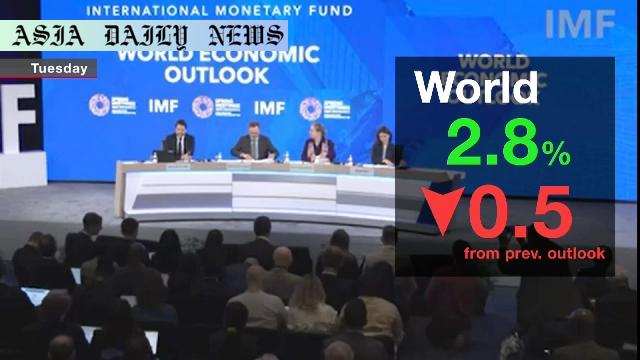trade friction: The latest IMF forecast reveals a sharp drop in global economic growth, citing US tariffs and weaker demand.

Global Economic Forecast Faces Setback
The International Monetary Fund (IMF) has significantly revised its global economic growth forecast for 2025, reducing it to 2.8 percent from the initial projection of 3.3 percent announced in January 2025. This downward adjustment sheds light on the mounting challenges posed by escalating trade friction between major economies, particularly the United States and its trading partners. Citing this friction fueled by recent tariff policies and retaliations, the IMF warns of prolonged uncertainty and tighter financial conditions.
Central to this revision are “reciprocal” tariffs introduced by the Trump administration, triggering a wave of countermeasures from trading counterparts such as China and the European Union. The uncertainty surrounding trade policies has resulted in a weakened demand outlook, slow investments, and an increasingly fragmented global market landscape. With nations preparing for long-term impacts, stakeholders question the sustainability of the global recovery post-pandemic and amid geopolitical friction.
Global, Regional, and National Perspectives
The IMF’s forecast recalibrations paint a concerning picture across regions. In the United States, economic growth is projected to slow to 1.8 percent, reflecting a steep decline of 0.9 percentage points. Analysts have attributed this slowdown to two main drivers: heightened policy uncertainty and a softer demand outlook. Meanwhile, China’s economy, previously a dominant engine of global growth, is now expected to expand by merely 4 percent—a reduction of 0.6 percentage points. This is indicative of both external trade pressures and domestic challenges in maintaining a robust recovery trajectory. Japan, too, will experience a significant deceleration to a mere 0.6 percent growth, as export-reliant industries grapple with a slump in overseas demand.
The IMF’s analysis echoes a broader reality in which prolonged trade tensions erode investor and consumer confidence globally. Financial conditions are tightening as businesses reevaluate risks and consumers adopt cautious spending habits. With central banks likely to maintain restrictive monetary policies to combat inflation, the ripple effect threatens to further destabilize fragile economies worldwide.
The Broader Implications of Trade Friction
The implications of trade friction extend far beyond the immediate economic figures. For global businesses, disrupted supply chains have become a persistent challenge, causing delays, increased costs, and inefficiencies. Countries exporting commodities, high-tech products, or industrial goods are finding reduced access to critical markets they previously relied upon. Trade disputes between the world’s largest economies, the United States and China, exacerbate these bottlenecks by introducing more barriers and increasing operational complexities.
Moreover, experts are raising alarms about the long-term impact on emerging economies and developing nations. These countries, while contributing less to global trade tensions, often bear the brunt of consequences through volatility in their exports, limited access to capital markets, or dependency on external borrowing. If trade disputes persist, they could hinder investments in infrastructure, education, and other sectors crucial for sustainable development. In this interconnected global economy, the repercussions of friction between the major players reverberate widely, straining collaboration and undermining shared progress.
What Lies Ahead in Addressing the Challenge
In addressing the challenges posed by trade friction, multilateral organizations and governments face a daunting task of bridging divisions and fostering cooperative strategies. The IMF’s warning underscores the importance of restoring trust in the international trade system and stepping back from unilateral actions that provoke retaliatory moves. Experts advocate for renewed focus on dialogue through platforms such as the World Trade Organization (WTO) to mediate disputes and create updated trade frameworks reflecting 21st-century needs.
Simultaneously, the IMF has recommended targeted fiscal policies that can stimulate domestic economies without triggering inflation. Economic diversification and enhanced regional trade agreements may also provide less vulnerable pathways. While achieving these goals requires considerable effort and political will, they remain essential if nations expect to mitigate lingering uncertainties and achieve a stable global economic outlook.
The world stands at a pivotal intersection where cooperation, adaptability, and long-term strategy can counter the damaging impact of trade-related challenges. Whether global leaders can rise to this occasion remains to be seen.
Commentary
The Growing Concern Behind Trade Friction
As the International Monetary Fund (IMF) releases its revised global growth forecast, the underlying narrative surrounding trade friction takes center stage. The impact of these economic clashes is undeniable, not just in terms of numerical downgrades but with a wider lens on investment trends, operational challenges, and geopolitical tension. Trade has always been a cornerstone of global connectivity, yet current policies seem to reflect an emerging divide that demands thoughtful scrutiny.
The Role of Policy in Economic Stability
A deeper exploration into the IMF’s outlook suggests how interconnected policy decisions and market reactions prove to be. For the U.S., imposing reciprocal tariffs may have stemmed from a desire to level competition; however, the ripple effects have been anything but contained. The more restrictive trade environment inevitably puts pressure on industries reliant on global supply chains, resulting in decreased confidence from investors and businesses alike. This arguably reactive approach has thus shifted focus from collaborative economic growth to isolated financial preservation.
The Path Forward Amid Uncertainty
While the figures outlined by the IMF are concerning, they also highlight an opportunity. By reassessing frameworks for global cooperation, leaders can address the bigger question of ongoing sustainability. The WTO’s potential role in rebuilding fractured trade norms, alongside fiscal reforms grounded in innovation, could drive a more balanced system. However, this also underscores the need for local responsibility, where countries actively invest in sectors that enhance resilience against global instability.
Ultimately, trade friction provides lessons—not just challenges—to countries striving for competitiveness and innovation. The coming years will likely test whether policy decisions align with collaborative growth or deepen the divisions further within our global economy.


